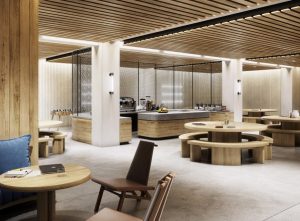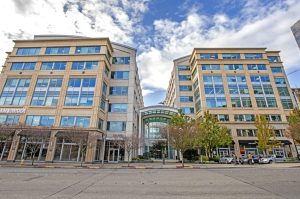Office Amenities With Tenant Appeal
How to create building features that encourage a return to the workplace.

Image by Pexels via Pixabay
Over the past two years, the office sector has undergone a transformation. At a time of economic headwinds and the rising appeal of remote work, office managers and developers must rethink how their spaces can best appeal to tenants and encourage a return to in-person work.
One place where they have seen particular success is upgrading amenities, from greenery-draped courtyards to flexible retail space. According to industry experts, these physical upgrades are indeed important, but so is how the buildings are used and the irreplaceable value of working in person.
Focus on flexibility

Elliott Ingerman. Image courtesy of Tribeca Associates
Elliott Ingerman, principal at Tribeca Investment Group, sees amenity upgrades as something that should first and foremost emphasize tenant experience, and offer flexibility in the ways a worker interacts with the building. “As a developer, our job is to create this canvas where businesses have the best ability to attract and retain talent,” Ingerman told Commercial Property Executive.
Tribeca embodied this philosophy in its $420 million redevelopment of 295 5th Ave., a historic Midtown Manhattan office building. For inspiration, Ingerman and his team looked toward Tribeca’s experience building and managing hotels and seeing firsthand what makes them uniquely appealing. A key step was bringing in an interior designer with hotel and restaurant experience. “Hotels [provide] opportunities to bring people back again and again,” Ingerman noted. “Our job was to create the most easy, fluid maneuvering environment,” a place in which guests move around constantly, and have plenty to do within the building. “People are working differently now; we see people coming in, going up, coming down an hour later and getting a coffee.”

The lobby of 295 5th Ave. in Midtown Manhattan. Image courtesy of Tribeca Associates
With this mindset, Tribeca’s redevelopment efforts were as focused on the experience of interacting with the building and its amenity spaces as they were on its uses. “We started from the entry point; the moment you come into contact with the building, we want it to be curated…our lobby is a hotel lobby,” Ingerman noted.
At the entry, guests are given a choice; they can either go right up to their offices, or they can go to an open space that includes a coffee bar with seating areas. For yet another option, guests can also proceed to the building’s larger amenity space, which is divided into retail, dining and fitness sections. Essentially, guests have access to the kinds of resources available in the surrounding area without leaving the building. This significantly drives up the appeal of working from the redesigned office while also providing benefits exclusive to working there. “People want to be in this electric, shared environment,” Ingerman said.

Amenity space at 295 5th Ave. Image courtesy of Tribeca Associates
The experience of working at 295 5th Ave. is further enhanced by its utilization of green space at the center of what Ingerman calls Midtown Manhattan’s “concrete jungle.” The firm had strategically used plant life throughout the building and its many public spaces, with its biggest task to turn the building’s courtyard into a garden.
“[This is] something people really wanted…that reinforced outdoor space; we tried to do everything we could to help people get outside and get fresh air,” Ingerman concluded.
Building an irreplaceable experience

Leslie Walling. Image courtesy of AEW Capital Management
Similar to the motivations behind Tribeca’s renovations, employee experiences and wish lists are the essential drivers of amenity upgrades at AEW Capital Management, notes Leslie Walling, director of the firm’s Private Equity Group and Office Sector Leader for the company’s asset management team. To Walling, in-person office work is less a necessity than an opportunity that “provides an irreplaceable component of an individual and company’s success:” a degree of collaboration and interaction that cannot be achieved remotely. Aware of office workers’ increased leverage, AEW makes sure “that their experience is commute-worthy,” Walling told Commercial Property Executive.
READ ALSO: Getting Corporate Tenants Back to the Office

Civica Office Commons. Image courtesy of AEW Capital Management
To Walling, a worker experience worth commuting for is defined not only by upgrades to amenity spaces and other physical elements, but by the power to “enhance productivity [in a way] that allows employees to do things they could not do at home.” One key area is in-person relationship and team building. The firm has taken to improving its indoor and outdoor offerings to encourage maximum collaboration and socializing. As at Tribeca’s properties, flexibility comes first. “We’re seeing more enhanced outdoor locations; we’ve provided outdoor seating, a tech-enabled environment and [spaces] for people to work indoors and out,” Walling said.
Additionally, the firm has paid attention to quality of life-focused enhancements, such as increased natural lighting, upgraded fitness centers, new security systems and flexible working arrangements. Aesthetically pleasant, safe and practical workspaces encourage the return that AEW is seeking. That brings about the physical collaboration necessary for success.
In terms of their actual uses, Walling envisions the upgraded spaces as benefitting employees by providing places to mentor, build relationships and even run errands. A healthy office work environment is not only vital to tenant success but is also a responsibility for property managers. As Walling summed it up: “It’s incumbent on office space to prove the opportunity for that collaboration to occur.”







You must be logged in to post a comment.